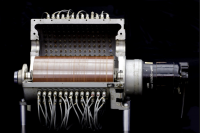








Drum memory was a magnetic data storage device invented by Gustav Tauschek in 1932 in Austria.It was widely used in the 1950s and into the 1960s as computer memory.
Drum memory, an early form of computer memory that actualy did use a drum as a working part with data loaded to the drum. The drum was a metal cylinder coated with recordable ferromagnetic material. The drum also had a row of read-write heads that wrote and then read the recorded data.
Magnetic core memory (ferrite-core memory) is another early form of computer memory. Magnetic ceramic rings called cores, stored information using the polarity of a magnetic field.
Semiconductor memory is computer memory we are all familiar with, computer memory on a intergrated circuit or chip. Referered to as random-access memory or RAM, it allowed data to be accessed randomly, not just in the sequence it was recorded.
Dynamic random access memory (DRAM) is the most common kind of random access memory (RAM) for personal computers. The data the DRAM chip holds has to be periodicaly refreshed. Static random access memory or SRAM doesn't need to be refreshed.